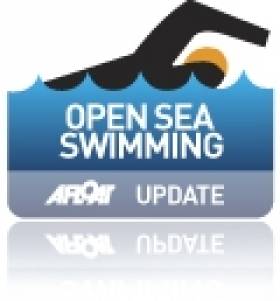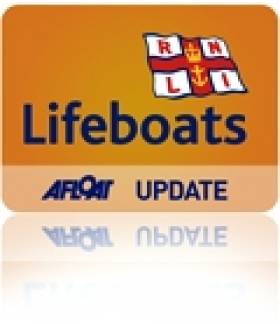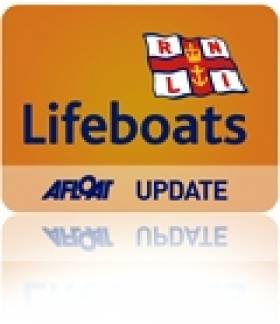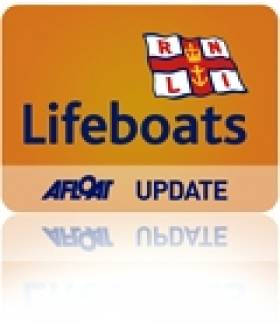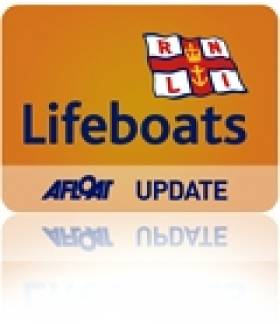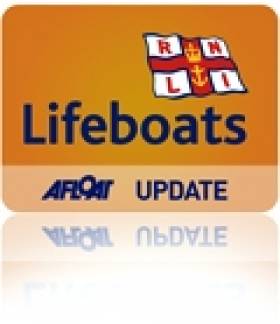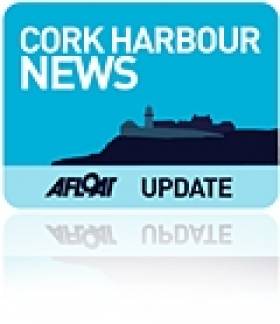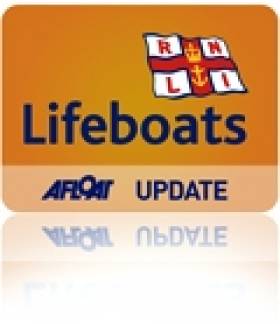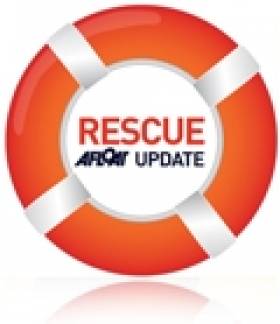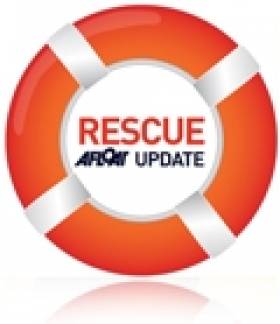Displaying items by tag: RNLI
Swim from Ballycastle to Rathlin Island Completed
Local French teacher Gary Knox has completed his swim from Rathlin to Ballycastle for Portrush Lifeboat Station on the very day that the station was celebrating its 150th Anniversary.
Gerry Doran Chairman of the Ballycastle Fundraising Branch texted the station at the start of the race and then at the end to confirm that Gary had completed his amazing feat!
This information was then relayed to the people who had gathered in Portrush for the Service of Thanksgiving and Vellum presentation.
Shelley Pinkerton, Chairman of the Portrush Fundraising Branch said
'This is an example of the innovative ways that people come up with to raise funds for the RNLI. It's very fitting that Gary completed the swim on the very day we are gathered to celebrate Portrush Lifeboat Station 150 years of saving lives at sea'
Gary who was not wearing wetsuit swam approximately 7 miles in 2 hours 55 minutes. The swim was for the RNLI and in memory of his friend and training partner, Ciaran McGinn who completed the endurance swim in 2007 and raised funds for his charity, Ballycastle RNLI.
Gary was accompanied by Portrush kayakers who followed the rib and provided him with energy drink every hour. In accordance with ILDSA rules, Gary was not permitted to touch the boat or kayak. Donations can still be made online at justgiving.com/gary-knox and there are collection boxes in the shops along the prom in Ballycastle.
Gary would like to thank Alan Wilson of Aquasports for providing boat cover, John Morton for advice and guidance, members of the Ballycastle Fundraising Branch and others for their assistance in organising the event.
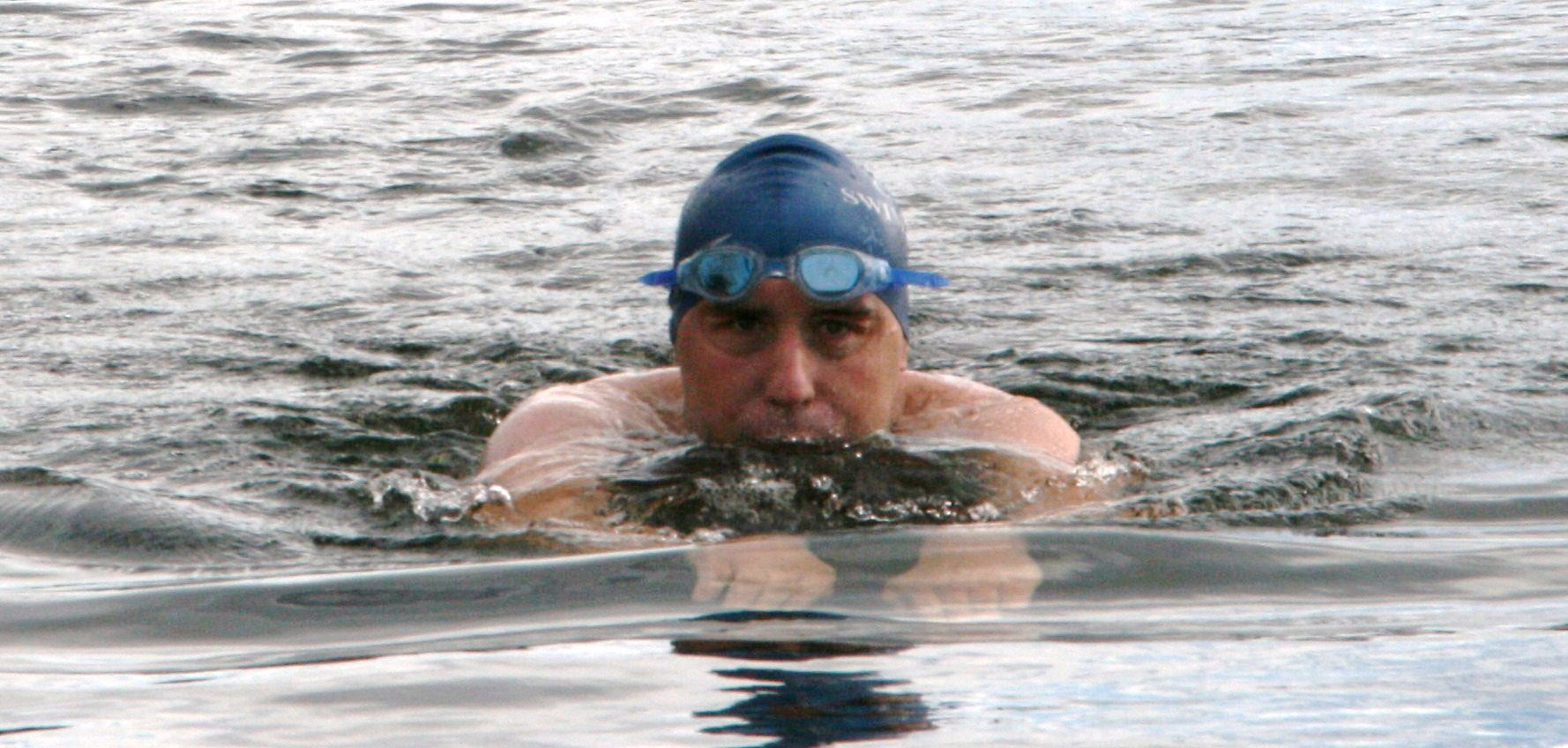
Gary nears the finish line
Portrush Lifeboat Station Celebrates 150 years
A service of thanksgiving marked the start of a year of events to celebrate Portrush Lifeboat Station's 150 years of saving lives at sea. The volunteer lifeboat crewmembers, fundraisers and supporters held a service in Portrush with the Inshore Boat 'The Ken and Mary' making her last appearance as a Portrush Lifeboat.
The event was held exactly 150 years after Laura, the Countess of Antrim helped establish the Lifeboat Station on the North Coast.
The service started with James Heaney, Chairman of Portrush Lifeboat Station giving a brief history of the station. Michael Hassan and Shay Reynolds sang a song that Michael had composed for the station called 'You're never on your own' and Ballywillan Band played the crews favourite hymns. By coincidence the band unveiled their new crest which includes a rope ring, a nod to their close relationship with the lifeboat station.
.
Father Sheehan, Reverend Simpson, Pastor Todd and Rev Kirkpatrick all did readings and prayers reflecting the dedication of the volunteer crews to saving lives at sea. Karl O'Neill one of the youngest crew members read the 'Lifeboat Prayer'
After the service John D Coyle MEconSc Chairman RNLI Ireland Council handed over a vellum to Robin Cardwell, Lifeboat Operations Manager. Mr Coyle praised the work of the crews and teams attached to the station and congratulated everyone on reaching this milestone. He reflected on the advances in technology which has made the lifeboats ever more sophisticated, but how the RNLI still depend on volunteers to crew them.
Robin accepted the vellum and thanked everyone for attending especially crew families who wait at home when the crews are out at sea. He thanked the crews for their dedication and commitment to training both on station and at Poole. He said that the vellum would be hung with pride at the station. Coxswain Willie McAuley presented Mr Coyle with a signed book on the history of the station and Shelley Pinkerton, Chairman of the Fundraising Team, proposed the vote of thanks to Mr Coyle, and reminded everyone why fundraising was so important to the RNLI.
After the formal proceedings ended Limavady Big Band sound played a medley of swing sounds which entertained everyone while friends past and present reminisced.
Related Safety posts
RNLI Lifeboats in Ireland
Safety News
Rescue News from RNLI Lifeboats in Ireland
Coast Guard News from Ireland
Water Safety News from Ireland
Marine Casualty Investigation Board News
Marine Warnings
Free Lifejacket Check in Dun Laoghaire Today
With the summer boating season coming to a close, the RNLI’s Sea Safety team is back in Dun Laoghaire this morning and people who use the water are being invited to get their lifejackets checked out for free and find out more about this vital piece of boating kit.
It's an ideal opportunity to get the jackets checked before putting them away for the winter or indeed before the start of the different winter series on the Bay.
The RNLI carried out a similar service during the summer and on that occasion Over 90% of lifejackets tested at Ireland's two biggest sailing centres failed the simple checks.
From 91 jackets tested in Cork and Dublin, 83 failed the free inspection.
The annual Lifejacket check service carried out by the institute was only taken up by 40 sailors from an estimated 1,000 competing crews at Cork week. 35 failed the test.
The RNLI lifejacket clinic took place yesterday at Dun Laoghaire marina and takes place again today.
The RNLI’s lifejacket campaign, first launched in June 2007, aims to encourage all who go to sea in their leisure time to always put their lifejackets on when going to sea, and then decide when (if at all) to take it off.
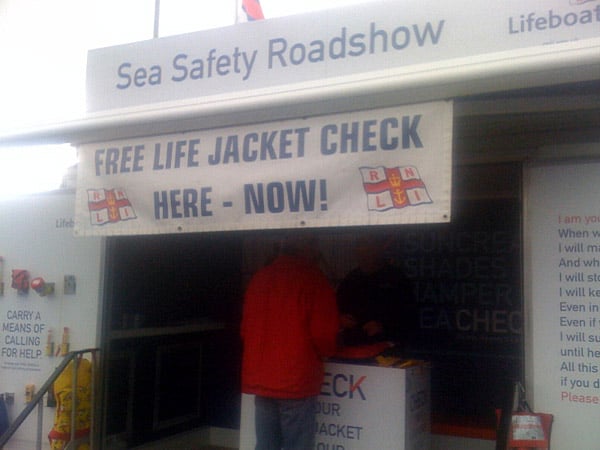
RNLI Divisional Sea Safety Manager, Nicola Davies, explains:
‘A lifejacket is useless unless worn, if it is worn incorrectly or if it is not in full working order. It’s much safer to get into the habit of wearing a lifejacket at all times when afloat, because it means you’ll be familiar with your particular lifejacket and how to operate it should an emergency situation unfold. In the summer months when boat owners may take family and friends who don’t often go afloat, it’s even more crucial to ensure that all on board, including babies and children, are wearing a well-fitted lifejacket.
‘A correctly fitting lifejacket will keep you afloat so that, should you end up in the water, you have time to overcome the initial shock and you can begin to think about survival. It will also keep your airways clear of the water, which is absolutely crucial because it only takes just a cup full of water in the lungs to make survival difficult and just over a litre to drown. A lifejacket also buys you time, this will allow for the search and rescue services to come to your aid. Our advice is not meant to spoil the fun of water users, but it is founded on the years of experience of RNLI lifeboat crew who know how unpredictable the weather can be and how quickly things can go wrong at sea.’
Lifejackets should not only be worn, but they need regular maintenance checks too. They should be stored in a dry, well-aired area when not in use. RNLI Sea Safety managers and volunteers around the coast of the UK and Ireland found that almost 35 per cent of lifejackets they’ve looked at during RNLI Sea Checks would, in their opinion, fail to operate.
Related Safety posts
RNLI Lifeboats in Ireland
Safety News
Rescue News from RNLI Lifeboats in Ireland
Coast Guard News from Ireland
Water Safety News from Ireland
Marine Casualty Investigation Board News
Marine Warnings
Bangor Lifeboat Crew to Receive Freedom of the Borough
The Atlantic 85 type lifeboat. the Jessie Hillyard. based in Bangor Harbour has two Yamaha 4-stroke engines giving a top speed of 35 knots. It features state of the art radar, chart plotter VHF radio and radio direction finding technology to enhance its lifesaving capabilities. Volunteer crew at Bangor take pride in a launch time of under four minutes from when their rescue pagers are activated.
Everyone connected with RNLI Bangor Lifeboat - the crew, station management, fundraisers and helpers - are all volunteers, giving freely of their time, braving all weathers, 24 hours a day, 365 days a year to help save life at sea.
Bangor's Lifeboat Operations Manager Kevin Byers also a volunteer is looking forward to receiving North Down Borough Councils highest award honouring the work of RNLI Bangor Lifeboat. He said
'We wish to publicly thank North Down Borough Council for their continued support and for honouring RNLI Bangor Lifeboat with this prestigious award' he added.
'It is a truly fitting tribute to the huge commitment and dedication of the Bangor volunteer crew and station personnel both past and present who have devoted so much of their time and effort to lifesaving at sea'
Related Safety posts
RNLI Lifeboats in Ireland
Safety News
Rescue News from RNLI Lifeboats in Ireland
Coast Guard News from Ireland
Water Safety News from Ireland
Marine Casualty Investigation Board News
Marine Warnings
Lifeboat Assists Vessel with Engine Failure on Lough Derg
At 7.30pm tonight Lough RNLI Derg lifeboat towed a vessel to safety after it suffered engine failure. 15 minutes earlier the lifeboat was requested to launch to assist three persons in distress on board the 38ft motor cruiser. The lifeboat with helm Peter Clarke, Eleanor Hooker and Colin Knight on board, launched with into winds west north-west, Force 5, gusting 6 with rough seas. Visibility was initially good with fading light.
The lifeboat located the vessel in Youghal Bay, close to Ryan's Point, and was alongside at 19.35hrs. All passengers were safe and unharmed. They were wearing their lifejackets. The vessel had dropped anchor to prevent being itself being grounded, but the anchor was not holding and the vessel was rolling side-on to steep waves. Once a tow was set up, an RNLI crew member weighed anchor and the vessel and her passengers were taken to the safety of the public harbour in Garrykennedy.
The lifeboat returned to station and was ready for service again at 20.30hrs
Related Safety posts
RNLI Lifeboats in Ireland
Safety News
Rescue News from RNLI Lifeboats in Ireland
Coast Guard News from Ireland
Water Safety News from Ireland
Marine Casualty Investigation Board News
Marine Warnings
Sailor Rescued from Burning Boat off Cork Coast
Youghal and Ballycotton lifeboat stations responded to the call and Ballycotton lifeboat station spoke of how they could see the black smoke in the distance as they rushed to the lifeboat station. An angling boat in the vicinity recovered the lone sailor from the sea. He was transferred to another angling boat and was immediately taken to Youghal where his condition was assessed by medical personnel.
Youghal and Ballycotton lifeboats were requested by the Coastguard to remain on scene while the pleasure craft blazed. Approximately an hour later the boat sank and the lifeboats returned to station.
Related Safety posts
RNLI Lifeboats in Ireland
Safety News
Rescue News from RNLI Lifeboats in Ireland
Coast Guard News from Ireland
Water Safety News from Ireland
Marine Casualty Investigation Board News
Marine Warnings
Hundreds Gathered for Cork Harbour Open Day
Cork Harbour Open Day proved to be a great success with hundreds of people enjoying the harbour and the free family events on offer. Throughout the day, the LE Aoife at Horgan's Quay welcomed families and children on board where they were given a tour of the ship and an insight into Navy life. The sailing race from Cobh to Blackrock, sponsored by the Port of Cork, was a huge success with over 50 boats taking part. Blackrock Castle opened the tower to the public and was busy throughout the day with people using the tower to watch the boats sail through the finish line at Blackrock.
Camden Fort in Crosshaven attracted hundreds of visitors to see the newly restored rooms and to learn more about the 'Rescue Camden' project. Also in Crosshaven the Coastal Rowing Association organised their end of season championship regatta where Passage West won all eleven races and the RNLI Station opened to the public.
'Dreamer' the fastest rigid inflatable boat (RIB) round Ireland was at the Port of Cork Marina for all to see. Built locally by Gale Force Ventures in Carrigaline and owned by current round Ireland record holder, Phillip Fitzgibbon from Co. Kerry, the 10 metre RIB can reach a speed of 65 knots.
Further events such as the World Rescue Challenge on North Custom House Quay, attracted large crowds over the whole weekend and in Cobh, the 'See You in Cobh' committee organised a crab fishing event on the promenade with over 80 children taking part.
One of the organisers of Cork Harbour Open day, Sara Dymond was thrilled with the day saying: 'The sun shone in Cork Harbour on Saturday and showed the harbour in all its glory. Cork Harbour Open Day aims to raise awareness of the different activities available for people in the harbour both on and off the water and this year we saw an exceptional turnout of people of all ages. There are endless activities to do in the Harbour and this year proved how popular the harbour is and how much people enjoy it. We hope to expand on this for next year.'
She continued: 'Thank you to all those who arranged events and helped out on the day.'
The idea for a Harbour Open Day emerged from discussions between various stakeholders involved in the development and implementation of the Integrated Strategy for the Harbour. A group comprising representatives from UCC, City and County Councils and the Port of Cork set about working together to engage users of the Harbour and to organise the Open Day.
Images from Bob Bateman on the Afloat Gallery HERE
Galway Lifeboat Launches Twice with Boats in Difficulty
Galway RNLI lifeboat was called out to two separate incidents on Galway Bay yesterday when two boats got into difficulty, one near Barna with three people on board and the other near Galway Docks.
The first incident involved a 30ft sailing boat, which was spotted drifting towards the shore between Rinmore Beach and Galway Docks, known as the Forty Acres. The boat was unoccupied and is understood to have broken its moorings near Mutton Island. The alarm was raised by a passing sailing boat and the Irish Coastguard tasked Galway lifeboat to the scene at approximately 10.40am.
The boat had run up on rocks close to the shore however the lifeboat crew of Helmsman John Byrne, David Oliver and Sean King managed to rig up a tow and bring the boat safely to Galway Docks.
The second callout happened near Barna at approximately 1.35pm. Three people in a 22ft open-deck fishing boat got into difficulty when the engine failed and the boat started drifting onto rocks half a mile west of Barna.
Two of the three people on board were wearing lifejackets and decided to swim for it as the boat veered towards rocks about 500 metres from the shore.
The Irish Coastguard tasked several rescue units to the scene including the Shannon Rescue Helicopter, the Aran Islands lifeboat, Galway lifeboat, and the Irish Coastguard Rescue Unit from Rosaveel. Two Galway Bay Sailing Club rescue boats already out at the club's regatta came across to assist in the rescue when they heard the distress call.
The three people made it safely ashore where Gardai from Salthill were waiting. They did not require medical attention. Attempts were made to take the boat in tow but it wasn't feasible and Galway lifeboat was stood down. The crew on the second callout were Helmsman David Oliver, John Byrne and Olivia Byrne.
Related Safety posts
RNLI Lifeboats in Ireland
Safety News
Rescue News from RNLI Lifeboats in Ireland
Coast Guard News from Ireland
Water Safety News from Ireland
Marine Casualty Investigation Board News
Marine Warnings
New Rescue Boat Launched for Ballybunion Sea and Cliff Rescue Service
Ballybunion Sea & Cliff Rescue Service in North Kerry officially launched their new Atlantic 75 rescue boat yesterday.
After three years of negotiations and build time the 7.5 metre Rigid Inflatable Boat arrived earlier this year. After several months of sucessful sea trials the boat entered full active service at the weekend, althought its first call out in anger occured last week to tow a stricken vessel that had lost engine power.
The unit depends fully on public donations and a small government grant to run the unit each year at a cost of over €40,000.
The boat was officially named by Derek Nagle, a member of the Duggan family in Ballybunion who have long been assosiated with the unit as supporters. The vessel was named the "Tommy C" after Tommy Duggan and his Wife Clara. The previous boat, an Atlantic 21 was named the "Clara T".
Related Safety posts
RNLI Lifeboats in Ireland
Safety News
Rescue News from RNLI Lifeboats in Ireland
Coast Guard News from Ireland
Water Safety News from Ireland
Marine Casualty Investigation Board News
Marine Warnings
Red Bay Crew in Line for '999 Hero Award'
Great to read this morning that the Red Bay RNLI lifeboat crew are in line for an award in the Belast Telegraph's 'Making The Difference Awards'. It is a new scheme to recognise those heroes across Northern Ireland whose stories never get told. The Red Bay lifeboat dramatically rescued a brother and sister from rocks on the north Antrim coast at the start of August. We reported it HERE.
The pair were stranded while walking in the beautiful but dangerous boulder field at Fair Head rock. After raising the alarm the crew quickly launched the Atlantic 85 lifeboat Geoffrey Charles and battled through rough waters to reach them.
In order to get to the frightened pair, a 'lifeline' had to be created with a rope. Lifeboat crew member John Walsh had to bravely put on a drysuit and lifejacket, enter the water and swim out to them.
Helmsman Paddy McLaughlin, who has been a member of the RNLI since he was 17, said it was a difficult operation.
"It was a tricky rescue, it took about three hours all in," he said.
"It was just hard to reach them because of the location of the rocks. But we got them safely ashore."
Mr McLaughlin said they are "just doing what they are trained to do".
"We aren't in it for the glory. As soon as we get the call the training just kicks in," he said.
"I suppose you don't think about it."
More on the awards HERE.
Related Safety posts
RNLI Lifeboats in Ireland
Safety News
Rescue News from RNLI Lifeboats in Ireland
Coast Guard News from Ireland
Water Safety News from Ireland
Marine Casualty Investigation Board News
Marine Warnings


























